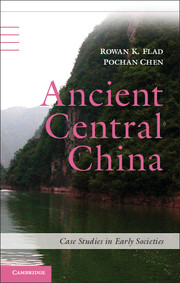Book contents
- Frontmatter
- Contents
- Figures
- Tables
- Boxes
- Acknowledgments
- 1 Introduction: Centers and Peripheries in the Ancient Yangzi River Valley
- Part I Setting the Stage
- Part II Political and Cultural Topographies
- Part III Topographies of Economic Activity and Ritual
- 7 Economic Topographies: Production, Exchange, and the Integrating Role of Salt
- 8 Ritual Topographies: Sacrifice and Divination
- 9 Ritual Topographies: Burials and Social Identity
- 10 Conclusion: Landscapes of Interaction and the Interaction of Landscapes
- Glossary
- Bibliography
- Index
7 - Economic Topographies: Production, Exchange, and the Integrating Role of Salt
Published online by Cambridge University Press: 05 February 2013
- Frontmatter
- Contents
- Figures
- Tables
- Boxes
- Acknowledgments
- 1 Introduction: Centers and Peripheries in the Ancient Yangzi River Valley
- Part I Setting the Stage
- Part II Political and Cultural Topographies
- Part III Topographies of Economic Activity and Ritual
- 7 Economic Topographies: Production, Exchange, and the Integrating Role of Salt
- 8 Ritual Topographies: Sacrifice and Divination
- 9 Ritual Topographies: Burials and Social Identity
- 10 Conclusion: Landscapes of Interaction and the Interaction of Landscapes
- Glossary
- Bibliography
- Index
Summary
Introduction
Here we turn our attention to the region's economic topography through a focus on the spatial arrangement of locations where resource extraction, production, and exchange took place. Among the nodes in such topographies are sources of plant and animal resources; mining sites or other source locations for raw materials; locations, such as workshops, where materials were transformed into finished products; and roads, other transportation networks, and markets or places for economic exchange.
Of course, the spatial distributions of household production and other aspects of domestic economic activity parallel residential settlement patterns. Furthermore, because the production and exchange of material culture (particularly ceramics) define the spatial extents of archaeological cultures, these aspects of the economic and cultural topographies are intimately related. Likewise, when economic production and exchange are important factors in the political control of a region by a ruling elite, economic and political topographies are closely tied to one another. Nevertheless, examining the geography of economic activity forces us to different starting points in our assessment of regional patterns of activity.
- Type
- Chapter
- Information
- Ancient Central ChinaCenters and Peripheries along the Yangzi River, pp. 171 - 208Publisher: Cambridge University PressPrint publication year: 2013

